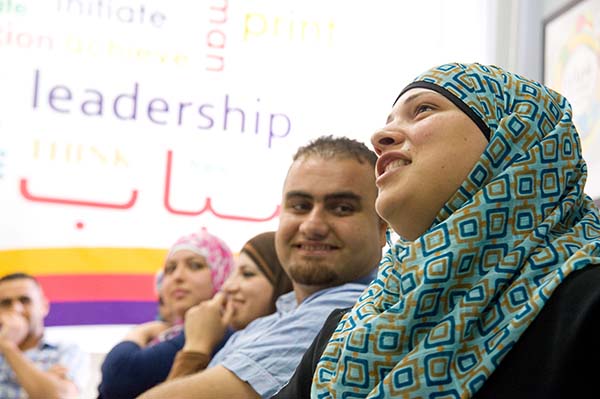About Gender
What we do
Grounded in Catholic social teaching, CRS’ integral human development (IHD) framework places the dignity of the human person—female and male—at the center of all that we do. It highlights the importance of addressing the specific needs, vulnerabilities and risks of women, men, boys and girls (WMBGs) as well as gender-based inequalities in systems, structures and access to assets. IHD acknowledges that personal well-being and true equality can only be achieved in the context of just and peaceful relationships.
Similarly, CRS recognizes that gender inequality critically impacts and intersects with trends of poverty, vulnerability and injustice—key areas where we seek transformational change. However, if gender roles, norms and dynamics are not considered within households, communities and our own teams, our projects miss opportunities to maximize impact and may even deepen existing inequalities. Systematically addressing gender inequality both internally and in the communities where we work is central to achieving IHD and the aspirations of CRS’ agency strategy, Vision 2030.
CRS’ Gender Equality Conceptual Framework
CRS’ gender equality conceptual framework, based on IHD, posits that gender equality is an important goal in and of itself and will only be achieved when there is equity in critical domains explained below. Specifically, in order to achieve gender equality, women, men boys and girls of all ages and abilities, must have the support of fair and just structures and systems that allow for 1) equitable access to and control of resources, assets and services; 2) effective participation and leadership, 3) shared power and decision-making, and 4) equitable roles, responsibilities, workload and time use. These domains are often interconnected.
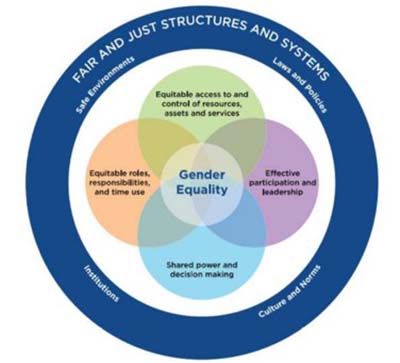 CRS’ conceptual framework for gender equality recognizes that the systems and structures we operate within are crucial for the realization of the other domains. Creating an enabling environment within the context of fair and just systems includes activities at multiple levels that promote safety and security of all people, just laws and policies that underpin equal rights for all members of society, strong and equitable institutions and cultural and societal norms that respect and promote equality, freedom and the dignity of all people.
CRS’ conceptual framework for gender equality recognizes that the systems and structures we operate within are crucial for the realization of the other domains. Creating an enabling environment within the context of fair and just systems includes activities at multiple levels that promote safety and security of all people, just laws and policies that underpin equal rights for all members of society, strong and equitable institutions and cultural and societal norms that respect and promote equality, freedom and the dignity of all people.
-
Equitable access to, and control over, resources, assets and services is critical for the achievement of gender equality and empowerment of women. Gender equality in the distribution and access of resources has positive multiplier effects for a range of key development goals, including poverty reduction and the welfare of children. Programming teams must look at levels of control, or the ability to make decisions on the use of a certain resource, information or asset.
-
Likewise, women and girls lack decision-making power relative to men (and boys) in several areas. Across all societies there are myriad examples of unequal control over decision-making—from how to spend income earned by women or the family to what a family should produce, sell or buy. In some instances, we know that an increase in access to important assets can lead to more household decision-making power for women.
-
Women and girls generally face inequality in participation and leadership, particularly in terms of decision-making or leadership roles in public fora and governance entities. Discriminatory laws, rules and practices hold women back, as do limits on education and income.
-
Roles, responsibilities and time use refers to the socially accepted roles for both men and women and the inequities that occur when these roles are unbalanced. Globally, women tend to have far more roles and responsibilities than men particularly about household and reproductive work. This imbalance disempowers women and girls from participating fully in economic, education and governance opportunities, further contributing to their marginalization and subordinate status.
CRS recognizes that gender inequality cannot be understood and effectively confronted in isolation from the myriad of other forms of vulnerabilities. Any use of the conceptual framework, therefore, must also approach analysis of patterns within each of the domains with a focus on intersectionality.
How We do it
Our work on gender equality within programming and operations around the globe is guided by CRS’ Global Gender Strategy 2020-2030. The CRS 2020-2030 Global Gender Strategy renews the agency’s commitment to putting gender equality at the core of the agency’s mission and recognizes that systematically addressing gender inequality both internally and in the communities where we work is central to developing strategies and programs for individuals and communities to achieve human dignity and reach our goal of integral human development.
It commits us to understanding the differences in experience, constraints and opportunities (through analysis) that males and females face, including the underlying structural and systemic issues that have created and sustained unequal power relations between men and women. The strategy calls us to address these issues.
The Global Gender Strategy
-
Articulates how the commitment to gender equality is central to the principles of Catholic Social Teaching, Integral Human Development, social equity and inclusion;
-
Provides conceptual clarity for gender equality as a foundation and crucial component for CRS to achieve international development and humanitarian response objectives as well as to support agency and sectoral strategy implementation;
-
and clearly describes gender minimum standards and strategic priority areas (PAs), to ensure gender equity is addressed strongly and consistently in our programs and organizational culture.
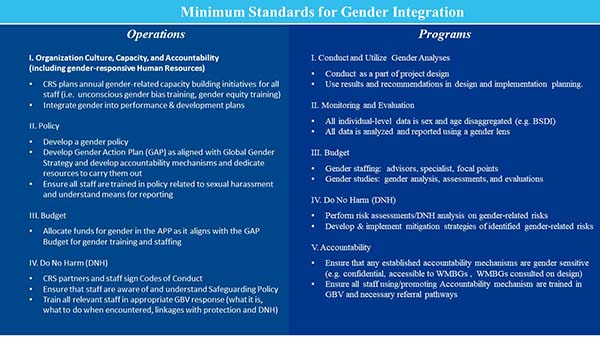
The 5 Priority Areas are:
PA 1: Women’s Empowerment. This PA recognizes that the empowerment and autonomy of women and the improvement of their political, social, economic status is a highly important end in itself but also essential for sustainable development. For example, a CRS program might strengthen women’s access to land by encouraging couples to share decision-making and ownership of their most important assets and work with key community influencers and gender champions. Check out the Women’s Leadership Curriculum, SMART Couples and Gender Transformative Approaches for SILC to see how this is done.
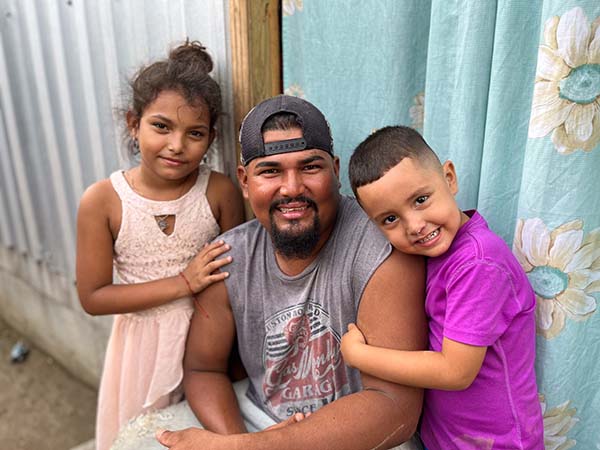
PA 2: Gender Equitable Masculinities. This PA emphasizes the importance of working with men and boys for the promotion and adoption of gender-equitable masculinities. CRS recognizes that programs that seek to realize equitable outcomes and work toward gender equality must work with men and boys to transform harmful gender norms and unequal power dynamics. For example, a program might use a Gender Transformative Approach such as the Male Change Agents, Engaging Men in Maternal and Child Health or Peaceful Masculinities) to promote healthy couple relationships and decision making.
PA 3: Adolescent Girls and Young Women Empowerment. This PA uses the life-cycle approach, which recognizes that approaches and outcomes highlighted in PA 1 may not necessarily be appropriate for adolescent girls and young women who face a number of specific risks, constraints and opportunities. It focuses on empowering adolescent girls and young women, aged 10-19, to lead full, healthy, productive and peaceful lives. For example, a program might apply a gender lens in youth-focused curricula while ensuring safe spaces for adolescent girls and young women, and support community norm change through community conversations on the rights of women and girls, youth and gender clubs and engaging parents and families holistically.
PA 4 Gender-Responsive Emergency Programming. It is well established that women and girls experience emergencies differently from men and boys. By recognizing these differences and unique needs, under this PA, CRS can integrate gender-responsive approaches and protection measures to ensure safe and dignified programming within emergencies. For example, CRS deliberately identifies and plans approaches for male and females to benefit equitably during cash transfer programming, develops referral networks and gender-sensitive feedback, complaint and response mechanisms and coordinates across sectors (participation in working groups, alliance building, clusters, etc.).
PA 5 Gender Based-Violence Prevention and Mitigation. CRS knows that the effects of violence are felt at the individual, family, and community levels and that instances of GBV pose a major threat to the IHD of project participants but also to the achievement of sectoral outcomes. This PA is dedicated to preventing and mitigating gender-based violence including harmful practices. See CRS’ Safe and Dignified Programming site for more information. For example, a CRS program may include women’s self-help groups like such as in the Grupos de apoyo de mujeres (GAM) approach across Latin America and adapt programming based on the needs like this examples from the Resilience Food Security Activities (RFSA) in Kenya and Uganda.
The priority areas provide a framework for CRS staff in developing new projects/programs and/or in planning implementation for existing projects.
For more information, contact [email protected]
Research & Publications
-
Guidelines
CRS Global Gender Strategy 2030
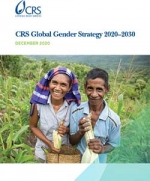
CRS Global Gender Strategy 2020-2030 Summary available in English, French and Spanish. More
-
Fact Sheet
CRS Gender Equality Framework
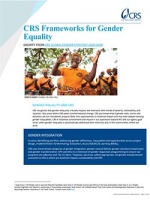
CRS recognizes that gender inequality critically impacts and intersects with trends of poverty, vulnerability and injustice—key areas where CRS seeks transformational change. More
-
Guidelines
Social and Power Dynamics Assessments
A Basic Guide for Busy Practitioners (4th Edition)
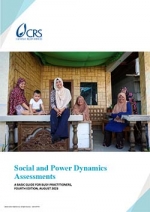
By providing practical assessment guidance that can be used in any program sector to examine social and power dynamics, this Basic Guide supports the design of conflict- and protection-sensitive, gender-responsive, disability-inclusive and politically savvy programs. More
-
Learning Briefs
Gender-Sensitive Labor-Saving Technologies & Practices
Learning from the Budikadidi Project in the DRC
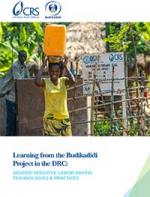
This DRC-based learning study was designed to drive greater understanding of whether the gender-sensitive labor-saving technologies and practices (GSLSTP) promoted by the Budikadidi project results in time savings and impacted gendered roles and responsibilities. More

